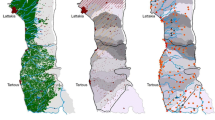Abstract
The Euphrates-Tigris river basin now faces severe water crisis that have been fueled by national development projects in a mainly water-scarce region. Increasing demand-induced scarcity is further complicated by a history of international tensions between the three riparian nations of Turkey, Syria and Iraq and has occurred in a changing climate. Water is a critical security issue for these nations. This essay analyses the causes of the water crises by reviewing the historical hydropolitical international relations of the region.
Similar content being viewed by others
Notes
Turkey, Syria and Iraq are the major riparians in the Euphrates-Tigris river system. Iran, also, contributes about 9 % of the Tigris river flow.
Shlomi Dinar, “Geopolitics of Hydropolitics: Negotiations over Water in the Middle East and North Africa,” SAIS Working Paper Series Working Paper, No.: WP/01/03, (2003), p. 9.
See Kibaroglu, Building a Regime for the Waters of the Euphrates-Tigris River Basin, p. 222.
The Treaty of Friendship and Good Neighbourly Relations between Iraq and Turkey, Protocol on Flow Regulation of the Tigris and Euphrates rivers and of their tributaries, United Nations, Legislative Texts and Treaty Provisions Concerning the Utilisation of International Rivers for Other Purposes Than Navigation, UN/Doc. ST/LEG/SER. B/12, 1963.
Kibaroglu, Building a Regime for the Waters of the Euphrates-Tigris River Basin, p. 170.
Ibid., p. 174.
Ibid., pp. 197–199.
Ibid., pp. 209–211.
Disputes over this province emerged in the 1930s; when following a plebiscite held at the end of the French mandate, Hatay became part of Turkey, although this was disputed by Syria. See Kibaroglu and Kibaroglu (2009).
The regional context in which water issues may or may not lead to inter-state conflict, and the role non-water issues played (i.e. territorial claims, support for separatist movements, security issues in general) are analysed, for example, by N. Beshorner (1992/93), Water and Instability in the Middle East, Adelphi Paper 273, Winter; Scheumann (2003); Lorenz and Erickson (1999).
Article IV of the Helsinki Rules on the Uses of the Waters of International Rivers, and Article 5 of the United Nations Convention on the Law of Non-Navigational Uses of International Watercourses are dedicated to the principle of equitable and reasonable utilisation and participation. In addition, these principles of the Helsinki Rules and the Convention enumerate the factors relevant to equitable and reasonable utilisation in Article V and Article 6 of these documents, respectively. See ILA, Report of the Fifty-second Conference Held at Helsinki, 484 et seq. (1966); General Assembly Resolution 51/229 of 21 May 1997 (Convention on the Law of the Non-Navigational Uses of International Watercourses).
For further details on the three-stage plan, see Kibaroglu (2002).
The final communiqués of the 16 Joint Technical Committee meetings were reviewed with the permission of officials of the State Hydraulic Works and revealed the above arguments—on file with the authors.
Protocol on Matters Pertaining to Economic Cooperation Between the Republic of Turkey and the Syrian Arab Republic, United Nations Treaty Series 87/12171, 17/7/1987.
Law No14 of 1990, ratifying the joint minutes concerning the provisional division of the waters of the Euphrates River, see http://ocid.nacse.org/qml/research/tfdd/toTFDDdocs/257ENG.htm. Accessed 30 May 2010.
Even though, the riparians had managed to build an institutional framework, namely the Joint Technical Committee (1980–92), they couldn’t succeed to empower it with clear and jointly agreed mandate. Instead, they continued unilateral and uncoordinated water and land development ventures. Thus, a series of diplomatic crisis erupted since the early 1970s.
“MIDDLE EAST: Talking about climate change”, 27/12/2012, http://www.irinnews.org/report/96905/middle-east-talking-about-climate-change
“Turkey, Syria, Iraq sign MoU for use of water resource”, 04/09/2009 http://english.people.com.cn/90001/90777/90854/6748071.html, Also; Turkey –Syria Relations http://www.mfa.gov.tr/relations-between-turkey%E2%80%93syria.en.mfa
N. Shamout, “Syria Faces an Imminent Food and Water Crisis”, http://www.chathamhouse.org/expert/comment/14959, 24/06/2014
A. Aso-el, “Irak ve Suriye deniz suyu içecek”, http://www.wsj.com.tr/article/SB10001424052702303473204580023111022443630.html, 11/07/2014
References
Ahmad M (2001) Agricultural policy issues and challenges in Iraq: short- and medium-term options. In: Kamil A, Mahdi (ed) Iraq’s economic predicament. Ithaca Press
Barnes J (2009) Managing the waters of Baa’th Country: the politics of water scarcity in Syria. Geopolitics 14:510–530
Benli Altunisik M, Tur O (2006) From distant neighbors to partners? Changing Syrian-Turkish relations. Secur Dialogue 37:232–234
Dombrowsky I (2010) The role of intra-water sector issue linkage in the resolution of transboundary water conflicts. Water Int 35(2):132–149
Harris LM (2002) Water and conflict geographies of the southeastern Anatolia project. Soc Nat Resour 15:743–759
Kibaroglu A (2002) Building a regime for the waters of the Euphrates Tigris river basin. Kluwer Academic Publishers, The Hague
Kibaroglu M, Kibaroglu A (2009) Global security watch turkey: a reference handbook. Praeger Security International
Kibaroglu A, Unver O (2000) An institutional framework for facilitating cooperation in the Euphrates-Tigris river basin. Int Negot J Theory Pract 5(2):312
Kut G (1993) Burning waters: the hydropolitics of the Euphrates and Tigris. New Perspect Turkey 9:5
LeMarquand DG (1977) International rivers. The Politics of Cooperation, West water Research Center, University of British Columbia, Vancouver
Lorenz FM, Erickson EJ (1999) The Euphrates triangle. Security implications of the Southeastern Anatolia project. National Defense University Press, Washinton
Scheumann W (2003) The Euphrates issue in Turkish-Syrian relations. In: Brauch HG, Liotta PH, Marquina S, Rogers PF, El-Sayed Selim M (eds) Security and environment in the mediterranean: conceptualising security and environmental conflicts. Springer, Berlin
Schiffler M (1998) International water agreements: a comparative view. In: Scheumann W, Schiffler M (eds) Water in the Middle East. Potential for Conflicts and Prospects for Cooperation, Springer, p 31–45
Turkish Ministry of Foreign Affairs (1996) Water issues between Turkey, Syria and Iraq. Percept J Int Aff 1:105
Williams PA (2011) Turkey’s water diplomacy: a theoretical discussion. In: Kibaroglu A et al (ed) Turkey’s water policy. Springer Verlag 197–214
Author information
Authors and Affiliations
Corresponding author
Rights and permissions
About this article
Cite this article
Kibaroglu, A., Maden, T.E. An analysis of the causes of water crisis in the Euphrates-Tigris river basin. J Environ Stud Sci 4, 347–353 (2014). https://doi.org/10.1007/s13412-014-0185-9
Published:
Issue Date:
DOI: https://doi.org/10.1007/s13412-014-0185-9




